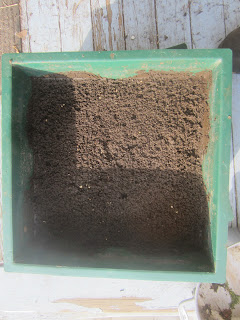I highly recommend getting a worm composter. I have two in my office and they make great worm castings (worm crap). It is nature's natural fertilizer.
You buy the bin and the worms. You add non-processed kitchen scraps and shredded paper. The worms break down the contents of the tray. They multiply and in a couple of months the thing really kicks in and processes kitchen scraps quickly.
Once the lower deck tray gets filled you just add a tray ion top. The worms complete their work on the lower deck and move upward searching for food. You just clean out the lower decks, store the worm casting in a plastic container, and the clean decks are available for new processing.
You have to drain excess water (once a month for me) using the drain plug at the bottom of the bin. The water is a great compost tea. No smells, no mess, and the red worms are inside the bins. They shy away from light so they won't go anywhere. Use red worms, not night crawlers. They just leave the bins and end up all over your house. The instructions on a commercial bin explain everything.
Here is a close-up of the stacked trays on one of my worm composters. The lower decks have finished worm casting ready for use in the garden. When the weather gets warm I'll take them outside for cleaning.
Here is some carrots tops put in the bin a month ago. You can see them slowly breaking down. I was lazy and didn't chop them up. Egg shells are good for the worms. They promote reproduction.
I just added some small carrots to the working bin.
After throwing in some food, I always add a handful of paper, then I just close the top.
Here is a picture of a deck where the worms are busy doing their thing.
A picture of the worms doing residual work on a lower deck.
A finished deck filled with worm casting.
A different finished deck.
Thing I put in the bins:
Shredded junk mail (no plastic)
Shredded newspaper
Shredded cardboard
Residual vegetables (all parts). The smaller the pieces, the better.
Egg shells (stimulates worm reproduction)
Thing I don't put in the bins:
Fruit scraps (works great but the fruit flies take over the house)
Processed foods
Onions (too acidic)
There are plenty of resources on the Internet on what can go in the worm bins.
A great article in the NY Times:
Worms Produce Another Kind of Gold for Growers
Here is the link:
http://www.nytimes.com/2013/01/01/science/worms-produce-another-kind-of-gold-for-farmers.html?_r=0
I highly recommend a worm composting bin to create great low cost organic plant food for your garden!






























